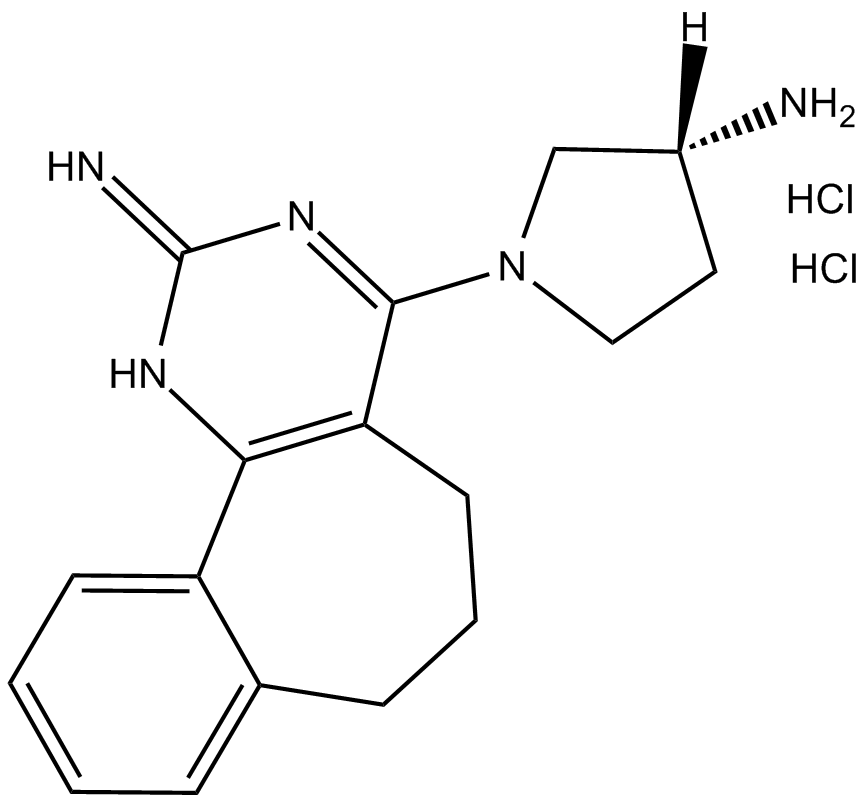A 943931 dihydrochloride |
| Catalog No.GC11121 |
Antagonist of histamine H4 receptor,potent and selective
Products are for research use only. Not for human use. We do not sell to patients.

Cas No.: 1227675-50-4
Sample solution is provided at 25 µL, 10mM.
A 943931, is an H4R (one of histamine receptor subtypes) antagonist [1] with high affinities to H4Rs of human (Ki = 5 nM), rat (Ki = 4 nM) and mouse (Kb = 6 nM) [2].
H4R is one of 4 known G-protein-coupled receptors (H1, H2, H3 and H4 receptors) of histamine for histamine to mediate its physiological functions [3].
HMC-1 cells incubated with A 943931 at a concentration of 300 nM for 20 min inhibited the increase in ALDH2 activity induced by H4R [4]. In microglia, A 943931 at a concentration of 10 μM partially abolish the release of TNF-α and IL-6 induced by histamine at a concentration of 0.1 μg/ml [5]. In bone marrow-derived mast cells, A 943931 inhibited the shape change induced by histamine (IC50 = 0.38 μM) [6].
Intraperitoneal administration of A 943931 at a dose of 33 μmol/kg potently inhibited itch induced by H4R agonist in mice [6]. In several preclinical models, H4R had been shown to be linked to inflammation [7]. A 943931 had excellent antagonistic activity both in vivo and in vitro across multiple species, displayed good oral bioavailability (90%) and excellent metabolic stability. This compound displays good efficacy in rat pain models and is a good anti-inflammatory agent in mice [8]. A 943931 has an in vivo oral bioavailability of 34% and a half-life of 2.6 h in rats [2]. A 943931 efficaciously reduced acute inflammatory pains induced by formalin in the flinch model and by carrageenan in mechanical and thermal hyperalgesia models in rats [9].
References:
[1]. Erich H. Schneider and Roland Seifert. The histamine H4-receptor and the central and peripheral nervous system: A critical analysis of the literature. Neuropharmacology, 2015, xxx:1-13.
[2]. Rogier A. Smits, Herman D. Lim, Tiffany van der Meer, et al. Ligand based design of novel histamine H4 receptor antagonists; fragment optimization and analysis of binding kinetics. Bioorg. Med. Chem. Lett., 2012, 22: 461-467.
[3]. Huaqing Liu, Robert J. Altenbach, Tracy L. Carr, et al. cis-4-(Piperazin-1-yl)-5,6,7a,8,9,10,11,11a-octahydrobenzofuro[2,3-h]quinazolin-2-amine (A-987306), A New Histamine H4R Antagonist that Blocks Pain Responses against Carrageenan-Induced Hyperalgesia. J. Med. Chem., 2008, 51:7094-7098.
[4]. Silvia Aldi, Ken-ichi Takano, Kengo Tomita, et al. Histamine H4-Receptors Inhibit Mast Cell Renin Release in Ischemia/Reperfusion via PKCε-Dependent Aldehyde Dehydrogenase Type-2 Activation. J. Pharmacol. Exp. Ther., 2014, 349(3):508-17.
[5]. Jin Zhu, Chen Qu, Xiang Lu, et al. Activation of Microglia by Histamine and Substance P. Cell Physiol. Biochem., 2014, 34(3):768-80.
[6]. Harald Engelhardt, Rogier A Smits, Rob Leurs, et al. A new generation of anti-histamines: Histamine H4 receptor antagonists on their way to the clinic. Curr. Opin. Drug Discov. Devel., 2009, 12(5):628-43.
[7]. Jeffery M Cowden, Fuqu Yu, Homayon Banie, et al. The histamine H4 receptor mediates inflammation and Th17 responses in preclinical models of arthritis. Ann. Rheum. Dis., 2014, 73:600-608.
[8]. Rob Leurs, Paul L Chazot, Fiona C Shenton, et al. Molecular and biochemical pharmacology of the histamine H4 receptor. British Journal of Pharmacology, 2009, 157: 14-23.
[9]. David Burns, Niu Shin, Ravi Jalluri, et al. Annual Reports in Medicinal Chemistry: H4 Receptor Antagonists and Their Potential Therapeutic Applications. Burlington: Academic Press, 2014.
Average Rating: 5 (Based on Reviews and 14 reference(s) in Google Scholar.)
GLPBIO products are for RESEARCH USE ONLY. Please make sure your review or question is research based.
Required fields are marked with *




















